
You are reading the older HTML site
Positive Feedback ISSUE
41january/february 2009
grant fidelity
A-534B integrated amplifier
as reviewed by Kent Johnson
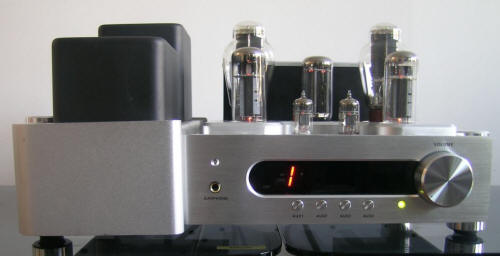
|
KENT JOHNSON'S SYSTEM
LOUDSPEAKERS
ELECTRONICS
SOURCES
CABLES
ACCESSORIES SECOND SYSTEM
LOUDSPEAKERS
ELECTRONICS
SOURCE
CABLES
ACCESSORIES
|
In Issue 40 of PFO, I wrote about the Chinese-made Grant Fidelity CD-327A tubed CD player ($949). I received this CD player, along with an A-534B 300B tubed integrated amplifier, an RPF-120 AC line conditioner, and various cabling, from Grant Fidelity for review. Grant Fidelity strives for an overall synergy with their equipment and suggests that it be used as a system.
I wanted to get an idea of how the CD player sounded on its own, however, before listening to it in combination with the Grant Fidelity amplifier and other components.
I found the CD-327A produced excellent sound through my reference system and I have used it as the source component for auditioning the A-534B amplifier. The A-534B is a Class A, single-ended triode amplifier (SET). It sells for $1979.
Description
The A-534B integrated amplifier is substantially built. It measures approximately 19 by 14.5 by 9.5 inches, WDH, and weighs approximately 58 pounds. The amp produces 8.5 Watts per channel at 1.1% distortion, or less, according to the owner's manual. An attractive, useful, and easy to remove tube cage is included. I left it off during my auditioning, the better to see the lovely glow of the tubes themselves.
The tube complement consists of one 5U4 rectifier tube and a pair each of 12AX7s, EL34s, and 300Bs. All of the tubes are Chinese. It is the use of EL34s as driver tubes, according to Ian Grant, that makes this 300B amp remarkable. Grant Fidelity states that the A-534B will successfully drive speakers as low as 86dB efficiency thanks to this unique design. The tubes are all guaranteed for 90 days. Ian Grant informed me that his experience has been that tubes will typically fail within that time frame or last until they wear out.
I think the A-534B is an attractive amplifier. There is a lot of brushed aluminum and chrome. The transformers are covered in a matte black finish. The On/Off switch is on the left side of the A-534B amplifier (facing the listener). The front of the amp includes a standard quarter-inch headphone jack toward the left side. In the center are four buttons for selecting the four line level inputs. (There is no built-in phono stage.) The input in use is displayed with a large bright red numeral in the central display area. To the right of the input buttons is a large volume knob. Just below and slightly to the left of the volume knob is an led. It glows red when the amp is first turned on—for about ten seconds—and then turns green to tell the listener that everything is working fine and that the amp is ready to use. I found the amplifier took about twenty minutes to warm up from cold before sounding its best.
On the rear of the amp are four pairs of RCA input jacks and an IEC AC connector. Binding posts for both 4 and 8 Ohm speakers are provided. These jacks and posts are substantial and of high quality. I used the 8 Ohm connections for both of the speakers I paired with the A-534B.
A heavy all-metal remote control that selects the input and adjusts the volume is included.
The A-534B is auto-biasing so there is no need for the user to worry about biasing its output tubes. This is a very welcome feature and makes the amp, for all practical purposes, as easy to use as anything solid-state. You turn it on; you adjust the volume; you listen.
The A-534B performed flawlessly during the time I had it. It is also an extremely quiet amplifier. With my ear to the speakers I used, there was just the faintest—and I mean faintest—noise emanating from the speaker itself. Given the number of tubes in use, I thought it was remarkably quiet.
Listening
I did my initial listening to the A-534B amplifier with the Xavian XN 270 Evolucione monitor speakers that were already in my system ($7200 with stands). These are purist two-way speakers that utilize a fabric dome tweeter and 7 inch midrange/woofer. Rated at 87dB efficiency, and using a sealed-box woofer alignment, I felt that the Xavians would quickly demonstrate, one way or another, how well the A-534B could drive speakers of their efficiency.
I used Grant Fidelity PC-1.5 AC cords ($149) to feed power to both the CD player and amp. Interconnects were my own DH Labs Revelation cables. I used my Alpha Core Goertz MI2 speaker cables with the Xavian speakers.
As the A-534B is the first SET amp that I have heard in my own listening room, I was curious as to how closely—if at all—it would conform to the stereotype regarding SET sound. This stereotype holds that SET amplifiers provide splendid midrange sound at the expense of the frequency extremes, especially the bass. Further, that they often add warmth to the sound that was never there in the first place.
I have heard SET amps with high efficiency horn speakers totally defy this stereotype. These systems had absolutely realistic reproduction across the whole frequency range. The bass, in particular, had all of the depth, slam, and volume that anyone might want. But these speakers have all been both very large and very expensive. So the question was: would this stereotype still have any validity when an 8.5 watt SET amp is used with speakers of average efficiency and conventional design?
Well, the A-534B/Xavian combination quickly proved the midrange part of the stereotype extraordinarily correct. Listening to The Very Best of Julie London (EMI 09463-12129-2-5), Julie's voice was superb on virtually all of the 50 tracks of this two-CD set. Despite lots of added reverberation, steely backing strings, and questionable production decisions, her voice remained lovely, feminine, and extremely natural.
I listened to quite a few female vocalists while auditioning the A-534B. Each sounded as good as I have ever heard her.
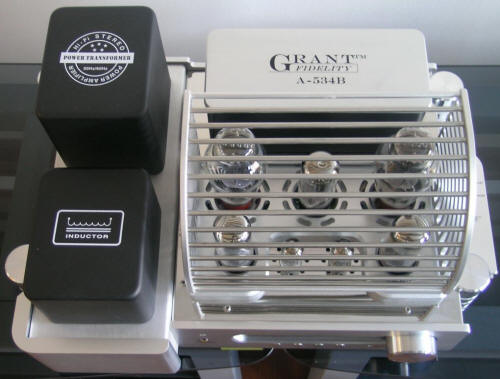
The Grant Fidelity amp showed yet again what a superb CD Eleanor McEvoy's Yola is. This CD continues to impress me with its great songwriting and wonderful melodies. It is a reference CD sonically as well (Blue Dandelion EMCD1).
If you have ever wondered why Eva Cassidy is held in such high esteem, you only have to hear her on Eva by Heart through the A-534B amplifier (Blix Street G2-10047). Her singing is so beautiful it really defies description; if her voice doesn't affect you emotionally, something is very, very wrong.
Nora Jones, Patricia Barber, Holly Cole, Trio Mediaeval, Kristin Chenoweth, and Diana Krall all made me reluctant to even listen to other music, each of them sounded incredibly gorgeous as well as uniquely individual. No overtones were lost in the process of reproducing their voices.
Male vocals faired wonderfully as well. Ray Charles sounds so young on Ray Charles and Betty Carter that hearing him is both heartwarming and heartbreaking. Their combined voices produced my favorite version of Cole Porter's "Ev'ry Time We Say Goodbye" (DCC Jazz GZS-1050).
James Taylor's Covers CD (Hear Music HRM-30829-02) sounded superb with every audiophile criteria that you would care to consider present and accounted for.
The A-534B made it easy to hear and appreciate the amazing vocal control Frank Sinatra had and his remarkable ability to imbue whatever he sang with absolutely plausible emotion.
Willie Nelson and Wynton Marsalis's CD, Two Men with the Blues, was as delightful as its pairing of these two artists appears initially incongruous. (Blue Note 50999 5 04454 2 4)
It was certainly no shock that the A-534B did vocal music extremely well. Being tubed, it would be a shock if it didn't. It was time now to hear how the A-534B did with somewhat larger scale orchestral music.
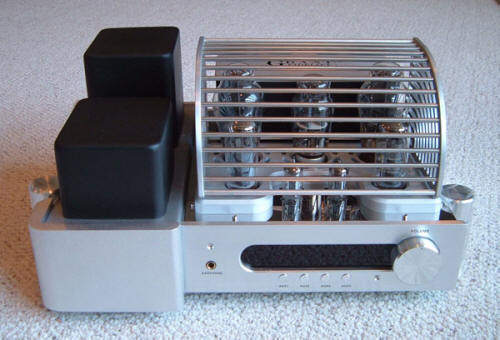
Medium-scale instrumental music fared extremely well. Wynton Marsalis's piccolo trumpet delivers both smoothness and bite on his In Gabriel's Garden CD (Sony SK 66 244). The trumpet has an almost pristine sound quality that lets it stand out from the English Chamber Orchestra around it. It does this without in any way sounding piercing—in the negative sense—an easy line to cross given the high frequency character of Wynton's instrument. Drums provide realistic impacts from their location in the rear of the soundstage, a soundstage with excellent depth. The organ sounds delicate; it is played at a fairly low level but can still be easily followed despite everything else going on around it. Overall, a wonderful recording.
Wynton's brother, Branford, also sounded very good on Romances for Saxophone (Columbia 468706 2). His playing conveyed what I can only describe as a vocal quality, a sense of it being sung rather than played. Unfortunately, the orchestra does not fare as well. This 1986 CD displayed, through the A-534B/Xavian set up, some of the steeliness and stridency from the string section for which CDs of its vintage are often criticized.
To this point, I was playing the A-534B at my normal listening levels with no sense of strain or effort on the amplifier's part. There was never any hint that the amp was running out of power; both treble and bass were reproduced with no losses that I could detect—so much for stereotypes. So I moved on to some large orchestral music.
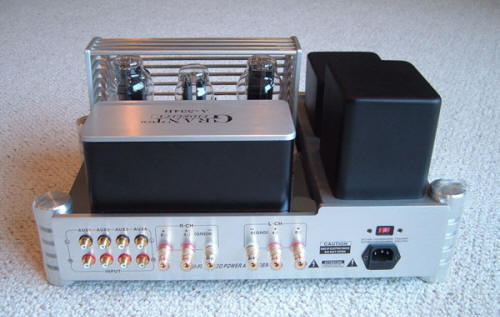
I used Riccardo Muti and the Philadelphia Orchestra's recording of Modest Mussorgsky's Pictures at an Exhibition (Philips D 193885) as my acid test of the A-534B's ability to reproduce dynamics and loud passages. It was here that I began to hear the limitations of the A-534B/Xavian combination. The sound was still extremely good but the dynamics were noticeably restricted during the "The Hut on Fowl's Legs" and "The Great Gate of Kiev" sections—no surprise really. This music needs some power behind it to sound realistic. In fairness, I did not push the amp particularly hard either but left the volume control where it had been for most of the rest of my listening, about the one o'clock position. I think the amp had more to give but since neither the speakers nor amplifier are mine; the idea of possibly damaging either one of them was not particularly appealing. (The more so since Dan Barnum of Half Note Audio, which distributes the Xavian speakers, is a black belt in some form of Korean martial arts. Not a guy I want to upset.)
I Try a Different Pair of Speakers
It was at this point that I replaced the Xavians with my Quad 21L2s. The Quads are rated at 88dB, and, at $1,500 per pair, are economically far more compatible with the amplifier and CD player. I had found the Quads to be very good sounding in my living room system but had never before listened to them in my main system. The Quads are designed for bi-wiring so they were connected to the A-534B using the MITerminator 4 bi-wire cables from the living room system.
A Digression or Two
I realize that I have totally failed to mention soundstaging so far. As a tube person and soundstaging fanatic, I guess I take it for granted that tube equipment will do great soundstaging and that you, the reader, will assume that without my mentioning it. The fact is that the A-534B/XN 270 soundstaged as well as I have heard it done in my listening room—a definite A+. Images extended beyond the outsides of the speakers themselves and depth was excellent. I now take for granted a level of soundstage reproduction that would have left me stunned not that many years ago. Even realizing that, I was still impressed by the A-534B's ability to bring each musical venue right into my room.
As long as I am digressing, I want to mention the Grant Fidelity RPF-120 AC line conditioner ($379). I introduced it into the system while I was listening with the Xavians and fed the A-534B from it. Unfortunately, due to having a limited selection of AC cords around, I could not connect the CD-327A to it as well. The CD-327A spent its time connected to my Monster HTS 3600 MKII.
Running the A-534B via the RPF-120 resulted in several improvements. The sound was slightly louder, a good thing, the bass was deeper and somewhat more dynamic, and low-level information was clearer—all these improvements were fairly subtle but well worth having.
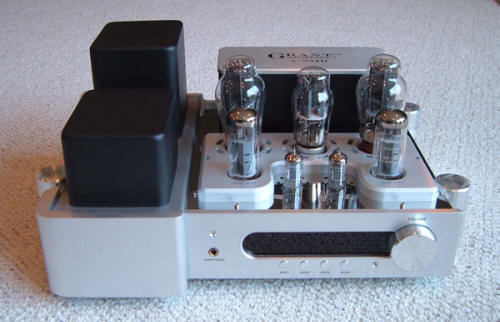
The Grant Fidelity AC cords and line conditioner are reasonably priced and made a worthwhile improvement in the overall sound quality of the system. Grant Fidelity's systematic approach to their components definitely works.
Listening with the Quad 21L2 Loudspeakers
The Xavian loudspeakers mated surprisingly well with the A-534B and revealed that the amplifier imaged incredibly well, was as silent as a tube amp can be, revealed low-level detail down to the limit of audibility in my listening room, offered superb mid-range performance, and did pretty much everything else at a very high level consistent with its power output.
The question now was, how much of this would I lose with a speaker far more likely to be partnered with this amplifier?
Not much, it turns out.
While rated as only 1 dB more efficient than the Xavians, the little Quads played considerably louder. I was listening to the Xavians with the volume control at the one o'clock position. I was able to lower this to around the eleven o'clock position with the 21L2s and the sound level was still slightly louder than it had been.
I put the Quads in the same position that the Xavians had occupied. It took me a few minutes to adjust the Quads toe-in and tilt. The 21L2s are short speakers and I have found a slight backward tilt really focuses the soundstage and improves its height.
I then re-listened to the CDs mentioned above. The A-534B through the Quads was just stunning.
The soundstage was spacious and airy and the Quads disappeared as well as the Xavians had done. There was excellent soundstage height. Listening to Ray Charles and Natalie Cole sing "Fever" on the Duets CD (HEAR Music CCD-2248-2) was just amazing; it crossed the line between listening to a performance and experiencing it firsthand. It was one of those situations where you just want to grab anyone you can find, drag then into your room, sit them down, and say, "You just have to hear this!" Both Ray and Natalie were incredibly life-like, there was all the detail you could possibly ask for, and images extended outside of the speakers. The performance was simply riveting.
The midrange performance remained magical. I listened to Tierney Sutton's Something Cool (Telarc CD-83548) and was again amazed at how realistically her voice was reproduced. On "Alone Together" Tierney sings accompanied only by an acoustic bass. Her voice is absolutely gorgeous. The bass manages to be melodic, detailed, and deep while staying so beautifully balanced that it never overpowers her voice while still harmonizing with it.
Treble through the Quads remained detailed and extended and never shrill. Re-listening to the Branford Marsalis "Romances" CD, the steely quality of the strings was detectably lessened. The CD sounded liquid and lovely and it was only the occasional steeliness that was minimized. Clearly the Quads do not have all of the ability of the five times more expensive Xavians to render detail. Without comparison to the more expensive speaker, though, the detail level of the Quads was more than satisfactory.
Bass dynamics were significantly restored on Pictures at an Exhibition. Although the bass lacked some of the precision that I had heard through the Xavians, it was louder, subjectively deeper, and noticeably more dynamic through the Quads.
The Grant Fidelity CD 327A, A-534B, and Quads had remarkable synergy and they used it to make music. It is as simple as that.
Headphone Listening
When I spoke with Ian Grant about reviewing this amplifier, CD player, and accessories, Ian stressed how good he felt the A-534B was as a headphone amplifier. So I did some listening with my AKG 240 headphones.
The AKG 240s are rated as a 55 Ohm load; Grant Fidelity suggests listening with headphones of 32 Ohm impedance. I don't know if this makes any audible difference in the resulting performance or not. As I understand it, the 300B tubes directly amplify the headphones just as they do speakers. You listen to pure triode tube output.
When headphones are plugged in, a blue led comes on above the headphone jack and the speakers are muted.
I have very limited experience with headphones and only with my fairly modest AKGs. I thought the sound quality through them was very good. I would expect it to be even better with better headphones. I wish I could provide some really useful insights as to how the A-534B compares to other headphone amplifiers but I just do not have the experience to do so.
For the person who does a lot of headphone listening, the A-534B's headphone amplifier is certainly an additional benefit and potentially a very significant one.
A Quibble, Replacement Tubes, and Upgrading
My only quibble with the A-534B itself concerns the volume knob. There is only a very small circular indentation in the face of the knob to indicate its position. This mark is too small to see at any reasonable distance. Further, the knob is polished chrome. I could not detect its movement when changing volume levels with the remote control. I think a larger index mark on the knob would be really helpful, even prudent. It's nice to know where the volume is set.
One concern a potential buyer of the A-534B amplifier may have is the cost of re-tubing it when the time comes. As of January 2009, Grant Fidelity offers a complete set of seven new tubes for $220—very reasonable in my experience. (The cost of an individual Shuguang 300B used in the amplifier is $85.) The problem with considering these costs is that Grant Fidelity estimates that the amplifier's tubes will last around 5,000 hours, or over four years, if used three hours a day. Replacement tube sets will no doubt be somewhat more expensive in 2013, although they will still probably be reasonable as tubes go. Keeping the A-534B in tubes should not be an expensive proposition. This, of course, assumes that the A-534B owner actually runs the tubes until they wear out.
It is far more likely is that the owner will have upgraded the tubes well before they ever die of natural causes. Grant Fidelity sells upgrade tubes for all of its amps and promises that they will raise the level of performance even further. I feel pretty confident that the allure of even better sound will be irresistible to the vast majority of A-534B owners.
Like Naim Audio and some other companies, Grant Fidelity provides its own upgrade path. A GF customer can start with the components themselves, add power cords and AC conditioning, upgrade the cabling, and eventually upgrade the tubes. He or she can also experiment with equipment racks, vibration dampening, and isolation cones. How far the performance of an A-534B amplifier-based system might ultimately be taken is truly intriguing considering how outstanding the basic package is already.
Summary
The Grant Fidelity A-534B amplifier's dazzling strength is a naturally beautiful midrange that makes every voice, male or female, popular or operatic, entrancing. Vocals just sound right. This is what a listener expects from tubes (and even more so from a SET amplifier) and the A-534B surpasses those expectations. Happily, this excellence does not come at the expense of the rest of the tonal range.
The treble is extended and realistic. Strings reveal all of their overtones; cymbals have lovely shimmer and sheen; and the higher woodwinds are reproduced especially well. The A-534B's treble performance may reveal the inherent shrillness and steeliness of some recordings but it never exaggerates them. The positive qualities of every recording are so involving that what is less than perfect is easy to overlook.
The bass performance of the A-534B is very good with the Quad 21L2 speakers. Solo bass on jazz CDs is realistic in level with excellent detail and dynamics. Charlie Haden and Ray Brown sound great. Massed acoustic basses have depth and gravity. Drums have excellent impact and reverberation.
At my normal listening levels, the bass never sounded deficient or lacking in dynamics. I never felt that there was anything missing or diminished at all. Sure, any or all of these bass qualities can be reproduced potentially better with more power. But that misses the point of this amplifier. Five hundred Watts will give you more bass impact but you will pay for it somewhere else within the tonal range. I never felt with the A-534B that any one aspect of the sound was being sacrificed for another.
My own listening supports Grant Fidelity's contention that this 300B tube amp can really be used with speakers of average efficiency (as long as some sanity is also involved). Every audio component involves compromises and they are skillfully and musically balanced within the A-534B. The overall result is musically superb sound.
I found all of the Grant Fidelity equipment that I auditioned to be impressively well made, totally glitch-free in operation, and, above all, extremely musical and involving. These considerations alone would make it easy to recommend them very highly. When the reasonable price of these components is factored in, calling them remarkable bargains seems inadequate. It has been an absolute pleasure listening to them. Kent Johnson
A-534B integrated
Retail: $1979
Grant Fidelity
web address:
www.grantfidelity.com

